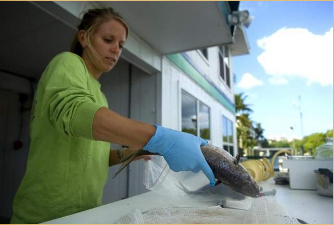
Katie McFarland, an FGCU graduate student, first saw large numbers of dead mullet floating in the bay and washed up along the shoreline Friday.
Saturday morning, McFarland took another trip onto the bay to take water samples and saw hundreds of mullet between FGCU's Vester Field Station and New Pass.
"From what I've heard, it's the whole bay," she said. "I've yet to see anything but mullet. It's crazy, the numbers of them."
Soon after he made that comment, McFarland found one dead Atlantic spadefish.
One suspect is red tide, a natural phenomenon that occurs when the toxic single-cell alga Karenia brevis undergoes a population explosion, or bloom.
To determine the strength of a red tide, scientists take water samples and count the number of Karenia cells per liter of water.
Fish can start dying when concentrations are "low," 10,000 to 100,000 cells per liter; the effects of medium concentrations, 100,000 to 1 million cells, are "probable fish kills."
According to the state's latest red tide status report, a Karenia bloom stretches for 30 miles along the shore from southern Lee County to northern Collier County and 30 miles offshore. Water samples taken Tuesday showed medium concentrations at Lighthouse Beach on Sanibel and low counts at Lynn Hall Park and Lovers Key State Park.
"Satellite imagery shows that the bloom we had up in Sarasota County worked its way down off Captiva and kept heading south," said Gary Kirkpatrick, manager of Mote Marine Laboratory's Phytoplankton Ecology Program. "Clearly it's in the area, but I can't tell what's killing the fish without having somebody do a toxin analysis. It seems likely that it's red tide."
But if it's red tide, which can kill any fish species, as well as birds, marine mammals and sea turtles, why is it killing almost exclusively mullet?
"I don't know why mullet, unless it got into an area of the estuary that was highly loaded with mullet," Kirkpatrick said. "It doesn't make real good sense."
Another possible reason for the fish kill, McFarland said, is a bloom of a different kind of algae that is depleting the water of dissolved oxygen.
As of Saturday, no dead fish have been reported outside Estero Bay.
"I've been fishing every day, from Chino Island to Boca Grande, and it looks good up here," said Capt. Shane Dooley, a Pine Island fishing guide and commercial fisherman. "Everything's clean. There's nothing bad."
Jimmy Jensen, co-owner of Jensen's Twin Palm Cottages and Marina and Jensen's on the Gulf on Captiva, said he hasn't heard reports of dead fish since mid-October.
"We've got nothing at all," he said. "I haven't heard anything from the bay side or the Gulf side."



Reader Comments
to our Newsletter